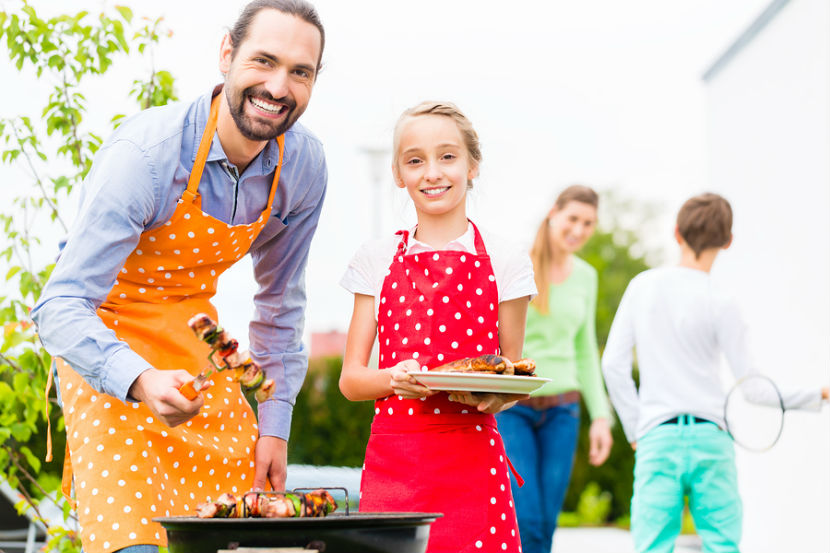
The heat is on, and BBQ season has officially arrived! Follow our five tips, and you’re sure to become a grill master…provided you don’t burn the chicken!
Tip 1: Wash your hands
Did you know that you should wash your hands for 20 seconds? Good hand hygiene can go a long way to prevent food poisoning.
Tip 2: Mix up the menu
Think beyond the typical steaks, hamburgers and hot dogs. Try grilling fish, fresh fruit, and even tofu for a change! You’ll find a handful of healthy meal ideas and cooking tips in Over the Grill!
Tip 3: Have two sets of BBQ tongs
Use one set for handling raw meat, raw fish, and raw poultry. Use the other set for taking cooked food off the grill. This prevents cross contamination between raw and cooked foods and helps to prevent
food poisoning. If you don’t have two sets of tongs, then wash them in hot soapy water and sanitize them after using them on raw food and before handling cooked food. The same applies to cutting boards and plates.
Simple Sanitizing Steps
- Combine 5 mL (1 tsp) of bleach with 750 mL (3 cups) of water in a labeled spray bottle.
- After cleaning countertops, cutting boards and utensils, spray sanitizer on the surface/utensil and let stand briefly.
- Rinse with lots of clean water and air dry (or use clean towels).
Tip 4: Bring out the digital thermometer
You can’t tell if a food is thoroughly cooked just by looking at it. Hamburgers, for example, may be brown in the middle, but may still not be cooked properly. Insert a
digital thermometer into the thickest part of the meat, and make sure that it’s at the right temperature before you take it off the grill. Remember to wash the thermometer in hot soapy water between readings. See the temperature chart below.
Tip 5: Pack it up
Bacteria grow quickly in food sitting out on your dining room or patio table. So, get packing and refrigerate any
leftovers within two hours. The two-hour rule also applies to fruit salad, melons, pasta and rice dishes too.
What temperature should you grill your food to?
To prevent food poisoning, cook your food to these recommended internal temperatures.
| Ground Meat |
| Beef, pork, veal |
71ºC (160ºF) |
| Chicken, turkey |
74ºC (165ºF) |
| Fresh Beef |
| Rare |
63ºC (145ºF) |
| Medium |
71ºC (160ºF) |
| Well done |
77ºC (170ºF) |
| Rolled beef roasts or steaks |
71ºC (160ºF) |
| Fresh Pork |
| Pork chops |
71ºC (160ºF) |
| Roasts |
71ºC (160ºF) |
| Fresh cured ham |
71ºC (160ºF) |
| Cooked ham (to reheat) |
60ºC (140ºF) |
| Hot dogs |
74ºC (165ºF) |
| Poultry |
| Chicken, turkey – pieces |
74ºC (165ºF) |
| Chicken, turkey – whole |
82ºC (180ºF) |
| Seafood |
| Fish |
70ºC (158ºF) |
| Shellfish |
74ºC (165ºF) |
| Leftovers |
| Reheated |
74ºC (165ºF) |
What about carcinogens in barbecued food?
Carcinogens are substances that can cause cancer. Grilling and barbequing meat or fish with very high heat over a direct flame can lead to cancer-causing compounds forming on food. Here’s what you can do to keep your grilling as healthy as possible:
- Grill lean cuts of meat
- Trim off visible fat before grilling since fat may drip on the hot fire and cause flames
- Avoid charring meat and fish
- Reduce the heat or raise the height of the grill if food is starting to burn
- Keep a spray bottle of water nearby to douse any flare ups
- Pre-cook chicken in the microwave to cut down on the grilling time
- Put plenty of cancer fighting veggies and fruit on the grill – either on skewers or on their own. Check out this recipe for grilled asparagus and sweet potato with curry.
How can a dietitian help?
A
dietitian can work with you to come up with an eating plan that meets your goals and specific nutrition needs. They can teach you how to read labels and how to choose foods that are safe and nutritious. Most employee health benefit plans cover dietitian services.
Connect with a dietitian today!
Bottom line
By following these simple tips, you can make sure the food you grill is not only delicious but safe. Always make sure to cook food to the safe internal temperature recommended and avoid charring and cooking foods over direct flames to reduce your risk of cancer.
You may also be interested in:
Over the Grill
Food Safety: Understanding Foodborne Illness
Test the Temperature – Use a Thermometer for Food Safety
This article was written and reviewed by dietitians from Dietitians of Canada.
Last Update – January 17, 2022